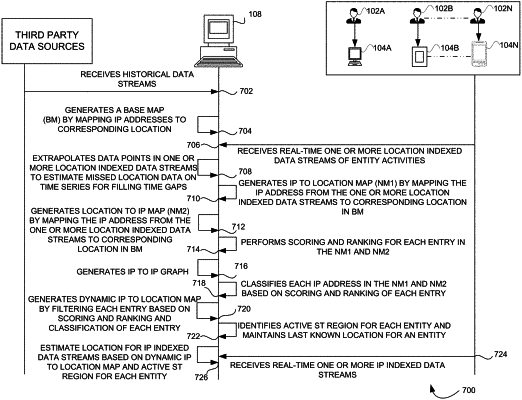| CPC H04L 61/5014 (2022.05) [G06N 20/00 (2019.01); H04L 61/103 (2013.01); H04W 8/26 (2013.01)] | 18 Claims |

|
1. A method for predicting a real-time location for non-location indexed data events based on a partially observable plurality of location indexed data streams, the method comprising:
obtaining, in real time, a plurality of location indexed data streams of entity activities from a plurality of independently controlled data sources, wherein the plurality of location indexed data streams partially characterizes an activity of at least one entity;
generating and updating in the real-time, an IP to location map by mapping a first set of internet protocol (IP) addresses from the one or more location indexed data streams to a first set of locations temporally, wherein entries in the IP to location map has a one-to-many relationship;
generating and updating in the real-time, a location to IP map by mapping a second set of locations from the one or more location indexed data streams to a second set of IP addresses temporally, wherein entries in the location to IP map has a one-to-many relationship;
scoring and ranking each entry in the IP to location map and the location to IP map based on a frequency of use of IP address, and a number of unique entity identifiers for each IP address or each location;
classifying each IP address in the IP to location map and the location to IP map as a static or a dynamic IP address based on the scoring and ranking of each entry;
filtering each entry in the IP to location map and the location to IP map based on the scoring and the ranking of each entry in the IP to location map and the location to IP map to generate a dynamic IP to location map;
training a machine learning model with (i) real-time location indexed data streams along with an active Spatio-Temporal region of each unique entity identifier, (ii) the dynamic IP to location map and a table comprising last known locations of the at least one entity; and
predicting the real-time location for the non-location indexed data event using the machine learning model that is trained using the dynamic IP to location map and the active Spatio-Temporal (ST) region for each unique entity identifier associated with the IP address, wherein the non-location indexed data event is an event of data production via an entity device without corresponding location of the entity device.
|